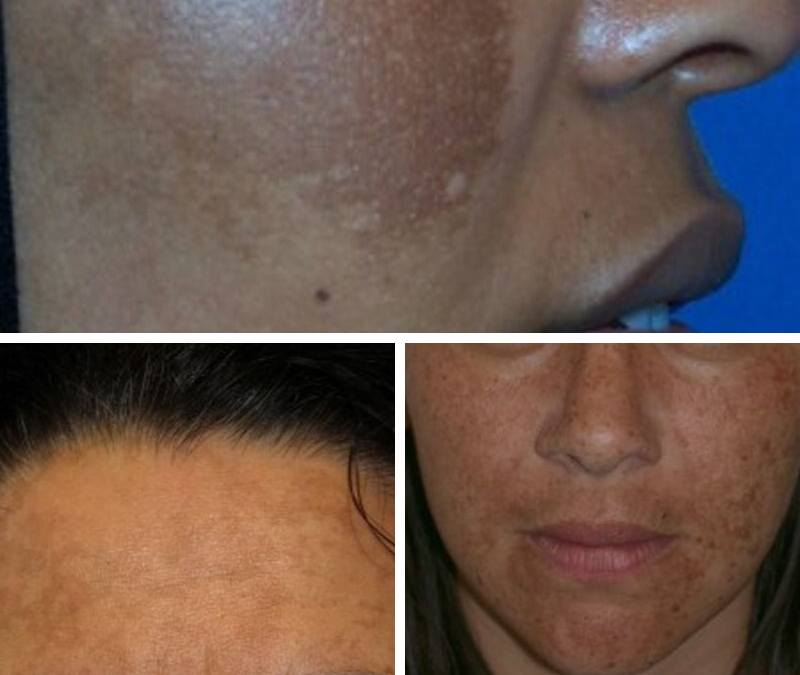What is MELASMA?
Melasma is a skin condition with symptoms of symmetrical, blotchy, brown or grey patches or patterns of facial pigmentation. The brown pigmentation is flat and usually has an irregular border. It most commonly affects the forehead or cheeks and is generally bilateral (both sides). Melasma can affect the arms, chest and back in addition to the face. It is a chronic (long term) condition or tendency. It is less
commonly called “Chloasma”. It has also been referred to as the “mask of pregnancy” as pregnancy hormones are a common trigger.
Who does MELASMA affect?
Melasma is much more common in women than men. It usually starts between the ages of 20-40 years of age. Melasma is more common in Fitzpatrick 3-4 skin types – those that are a mid-brown skin type and tan well. It is less common in pale skin or very dark skin types.
What causes MELASMA?
The increased pigmentation seen in melasma is due to overproduction of melanin by the skin’s pigment cells (melanocytes) which is taken up by the keratinocytes (epidermal melanosis) and deposited in the dermis (dermal melanosis, melanophages).
There are several triggers or risk factors that can cause melasma:
- Genetics (1/3 of patients have a family history of melasma)
- Sun exposure and sun damage
- Hormones – particularly estrogens, so pregnancy, the oral contraceptive and HRT can precipitate symptoms
- Certain medications apart from hormones. Immunotherapies and cancer medications can trigger melasma.
- Scented or deodorant soaps, toiletries and cosmetics may cause a phototoxic reaction that triggers melasma, which may then persist long term
- Hypothyroidism (under active thyroid)
- Stress
What is the best treatment for MELASMA?
Melasma is a chronic condition and generally will need ongoing treatment. The best results are usually obtained with a combination of treatment modalities.
General measures:
- If possible cease estrogen containing contraceptives – discuss other options with your doctor
- Sun protection year round, 50+ sunscreen or sunblock with Zinc Oxide. Broad brimmed hat.
- Cosmetic camouflage makeup
- Non-irritating cosmetics / cleanser / moisturiser
Topical preparations:
There are several topical preparations (skin creams/serums) that inhibit tyrosinase (which thus acts to stop new melanin formation in melanocyte cells)
- Compounded creams requiring a script from our skin GPs. These are mixtures of hydroquinone and anti-inflammatories /cortisones and vitamin A. Other topical treatments are also available and if suitable can be discussed with our GPs.
- Synergie Vanish is a product exclusively available from medical clinics, including GVSL. Vanish contains patented peptide technology and clinically proven ingredients such as oligopeptide-34 and liquorice extract designed to reduce the appearance of uneven pigmentation, sun damage and enhance skin clarity and luminosity. Apply sparingly to affected areas in the morning and evening prior to moisturising. Do not mix with acidic products such as Exfol-x. Ensure broad spectrum sun protection such as Uberzinc is applied after the serum to help prevent from sun damage and further darkening of hyperpigmentation.
- Synergie Suprema c+ is a powerful antioxidant-rich serum that reduces the appearance of hyperpigmentation at the source with 20% CMF Triacid Complex™, a trademarked blend, unique to Synergie Skin. Apply one pump in the morning prior to moisturising. Follow with sun protection.
Light and laser treatments:
The ideal light/laser treatment for melasma would destroy the excessive melanin pigment while leaving the surrounding cells unharmed. Unfortunately, this is hard to achieve as light or laser treatments always cause some heating or inflammation to surrounding tissues. The difficulty with melasma is that this inflammation can then lead to more deposition of melanin (post inflammatory hyperpigmentation). Using the correct wavelengths, settings, and skin cooling methods can limit this. Patients should be pre-treated with a tyrosinase inhibitor (see above).
Long pulse Q-switched Nd:YAG lasers (Revlite) are the preferred choice to achieve clearance of pigmentation without overheating the surrounding tissues and causing rebound hyperpigmentation. Fractional lasers (Acupulse), picosecond lasers and broad band light (BBL) may also be used in individual cases depending on other patient factors. Several treatments may be necessary, and post-inflammatory hyperpigmentation may complicate recovery.
Skin Peels: O Cosmedics Bio White peptide peel is an anti-aging, brightening and lightening peel that evens out skin tone and inhibits tyrosinase preventing pigmentation formation. It is perfect for aging, photo damaged, melasma, pigmentation and those needing a megadose of vitamin C!
Sun protection: The sun is the big culprit in triggering melasma. It is important to be wearing an SPF that uses physical blockers such as zinc and titanium dioxide. Steer clear from sunscreens that use chemicals such as oxybenzone. Chemical sunscreens don’t offer the same protection for melasma, in fact they may even trigger allergic reactions that can often make melasma worse. A good tip is anything over 50+ typically tends to be a chemical sunscreen.
Oral (tablet) treatments: Several oral tablet options are being studied for melasma, including tranexamic acid tablets. You can discuss whether this is an option for you further with our skin GPs as there are pros and cons, and contraindications to this approach.
Will MELASMA come back / return in the future? How do you prevent this?
Unfortunately the tendency to develop melasma remains despite treatments, unless an underlying factor (like pregnancy or estrogen containing medications) no longer exists. Therefore the key to successful ongoing results is a good relationship with an experienced dermal therapist who can develop a treatment plan to minimise or remove the melasma and keep it away. Ongoing diligence with sun protection including avoiding exposure, sunscreen/sunblock and wearing a hat is very important.
